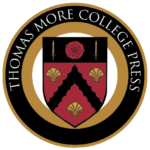 Thomas More College of Liberal Arts has established the Thomas More College Press to assist those who still seek the true, the good, and the beautiful through the printing of new and newly rediscovered works. Like the Catholic humanists of the past, the directors of Thomas More College Press see learning as nourished by both affection for the local and engagement with broader intellectual and cultural traditions.
Thomas More College of Liberal Arts has established the Thomas More College Press to assist those who still seek the true, the good, and the beautiful through the printing of new and newly rediscovered works. Like the Catholic humanists of the past, the directors of Thomas More College Press see learning as nourished by both affection for the local and engagement with broader intellectual and cultural traditions.
The Press recalls the rich world of Catholic humanism, which took a broad interest in all things that touched upon man’s life and actions—all that might lead to his happiness. Animated by a deep commitment to the unity of faith and reason, Catholic humanism was the scholarly disposition that emerged in the late middle ages, in part springing from a mature meditation on Scripture and the theology of the Incarnation, in part springing from the rich revival of classical learning through the careful production and study of Latin texts and the reintroduction of Greek originals. In some sense, Renaissance humanism can be described as a deeply Christian exploration of the famous words of the old Roman playwright, Terence:
Homo sum: humani nihil a me alienum puto.
I am a human being: and I deem nothing pertaining to humanity is foreign to me.
—Heauton Timorumenos (The Self-Tormentor)
The humanists fell in love with Greek, and in general took an interest in all languages—ancient and modern, eastern and western. They variously embraced ancient philosophers and naturally worked toward reconciling all these things to Christ. They restored the place of history and literature to the curriculum of general education, and placed a heightened value on music, art, architecture, and natural science.
As a humanist, Thomas More too fell in love with and mastered ancient languages, he saw learning as a diverse and lifelong project rooted in the study of Greek and Latin texts, and he thrilled with an amateur’s zeal at the exotic discoveries in natural science and explorations of Africa and the New World. In addition to housing one of the best libraries in England, More’s home was a veritable menagerie of odd artefacts, old coins, shells, plants, and living creatures from all over the world. St. Thomas More’s pet monkey even made it into the original version of the family portrait painted by Hans Holbein. Yet for all his wide-ranging interests, St. Thomas More remained grounded in the lived reality of his own beloved corner of England. Thomas More College Press holds up St. Thomas More as its patron—a scholar who was engaged in the vast debates of his civilization, while remaining attentive to his own home.